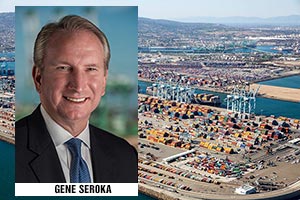Head of America’s Biggest Port Navigates Turbulent Year

LOS ANGELES — It has been a wild year for the people who choreograph the flow of goods in and out of U.S. ports.
The largest ship to ever visit North America docked in Los Angeles in February. In June, after nine years of construction, the Panama Canal opened a new passageway.
Then, in August, one of the world’s largest shipping lines, Hanjin Shipping Co., suddenly declared bankruptcy and left billions of dollars of goods marooned on ships across the globe.
In the meantime, the U.S. presidential election managed to turn trade into a bad word. Candidates on both sides say poorly negotiated trade agreements have given China and Mexico an advantage and cost U.S. jobs.
As executive director of the Port of Los Angeles, Gene Seroka runs operations at the nation’s largest port, which serves as the gateway for a fifth of all boxes shipped to America. Seroka has been on the job for two years. In two recent interviews, Seroka talked about the drama he’s confronted this year. Here is an edited version.
Q: During the bankruptcy of Hanjin Shipping Co., we heard a lot about the crisis of oversupply in the shipping industry. Does that impact the port?
A: It impacts the entire industry. It continues to put downward pressure on the entire cost structure. Every meeting we have is always about the sensitivity of cost structure and how we can drive value through the system at a much lower price point.
Q: Does that hit your bottom line?
A: Absolutely. Terminal reciprocal pricing, requirements on public bids, everything goes into that mix. Thankfully, because of the leadership we have at the port and the city, our financial strength is extremely good. The bond rating agencies reaffirmed our AA ratings recently.
Q: There’s been a slow growth rate for the combined imports and overall traffic at the ports of Los Angeles and Long Beach. Is that the new normal?
A: I don’t know if there’s any semblance of normalcy today. Dating back to the recession, the industry has changed profoundly and continues to evolve. There was a time where growth rates were in the double-digit arena, simply because of the amount of outsourcing [companies] were doing to Asia locations that really buoyed growth for consumer spending.
It used to be a multiplier effect, that U.S. GDP times X would be your container growth. That has flattened tremendously. I think we’d be pretty happy now if container growth was in the neighborhood of U.S. GDP [growth].
Q: What is driving that?
A: Retailers have watched their inventory levels with an even sharper eye than ever before. Consumer spending, although steady, has not seen big pops based on earnings capabilities and the ability to find bargains and make sure the family dollar is stretched as far as it can be.
Q: One argument for why Los Angeles has an advantage over the Panama Canal is that we can receive bigger ships. Will the port lose that advantage if carriers try to downsize to deal with overcapacity?
A: I really don’t think so. Those ships give them better fuel efficiency and they are much cleaner burning than their predecessor vessels. For the smaller ships, there’s no absorption rate. You’ve got a glut of capacity in every range of containership size that we have now.
Q: So, so far, no real impact from Panama?
A: That’s correct.
Q: There’s been a lot of talk about how bad China’s rise is for the U.S., in the current election cycle. How important is China to what you do at the ports?
A: It’s huge. The import-export market creates the great majority of the jobs here, in and around the port. It also has a direct offshoot to the domestic business that moves through our region. That trade creates all these opportunities and if we look at China as a whole, U.S. imports from China are about 60% of the ledger.
Q: Do you think there will be continued mergers and consolidations in shipping?
A: A couple things are going on right now. The cargo owners and logistics companies are looking very closely at the financial viability of their service partners, and not just the liners, but everyone throughout the supply chain. But there’s a particular interest in the liners after the Aug. 31 announcement by Hanjin Shipping.
With new [shipping carrier] alliances coming in, we are going to move from four major alliances to three. It’s my belief that folks will continue to talk to find those areas of opportunities.




